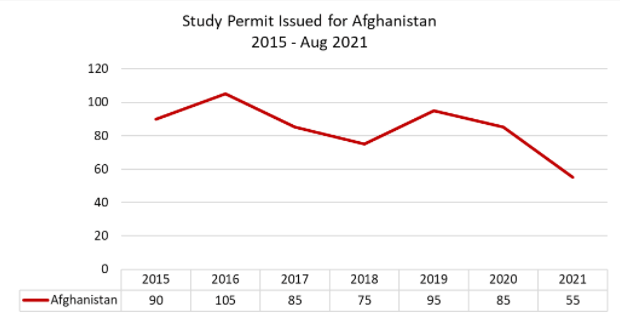When people speak about international students in Canada, India always comes to mind as the country has been consistently the biggest source for foreign learners. South Asia, where India is located, is a rich source of young students pursuing overseas education, particularly in Canada. Apart from Indian learners, students from neighboring countries also pick Canada as their preferred study destination.
In this article, we will look at the trends in study permit issuance for South Asian nations over the last few years.
Key Takeaways
The number of South Asian students going to Canada for international education has been consistently increasing prior to the pandemic.
From the downtrend in 2020, international enrollment from South Asia to Canada has increased in 2021.
Nepal, Pakistan, and Sri Lanka have sent more students this year to Canada, surpassing the highest enrollment tally in 2019.
South Asian students’ motivation for choosing Canada as a study destination mainly revolves around the high quality of education and boosting job opportunities after graduation.
Other students from the region who opt not to return to their native country count on Canada’s post-graduation work permit and immigration program.

Afghanistan
We are witness to the political crisis and horrors that the country faced this year as it fell to Taliban forces. Behind the disruption are young learners who are aiming for a bright future through international education. Although the country has been sending only a few learners to study in Canada, it cannot be denied that there is interest among its youth for overseas studies. It has been reported that some Afghan international students have chosen to remain in their study destinations due to the threats in their homeland.

Bangladesh
In terms of population, Bangladesh is the third-largest South Asian country, with 166 million people at present. The country sends a decent number of students to Canadian institutions throughout the years, making it the 10th largest source of international students.
The graph below shows the growth in the Bangladeshi student market from 2015 to 2021:

Bhutan
Bhutan has been isolated from the rest of the world for generations, owing to its mountainous terrain and a determination to preserve itself from foreign influence and interference. However, in the latter half of the twentieth century, the country began to allow and seek more international engagement, a development that continues today.
The government’s acknowledgment of the necessity of educating Bhutanese residents was the key motivator of this development.
Bhutanese students are getting more international exposure throughout their undergraduate years, with thousands of students self-funding their studies overseas in addition to the government’s annual selection of about 200 students for international scholarships. Bhutanese youth are increasingly looking for work overseas as well.

India
Despite all of the travel restrictions and the uncertainties surrounding the COVID-19 situation, the number of Indian students approved to pursue higher education in Canada has increased. 83 percent. More students were approved in the first four months of 2021 than in the entire year of 2020.
In the months of January to April this year, the approval rate for study permits was 74 percent, with 67,000 permissions, compared to 49 percent (36,778 approvals) in 2020.
During the first four months of 2021, nearly three out of four Indian students were granted a study permit, up from one out of every two last year.

Nepal and Sri Lanka
From 2016 to 2019, 90 percent of study permits for Nepali students and 82 percent of study permits for Sri Lankan students were issued. In 2020, these percentages declined to 45 percent and 54 percent, respectively, due to the pandemic and related travel restrictions. These decreases were significant, but they were far smaller than the average for all South Asian economies.
In 2020, only 35% of all new study permits for South Asian students were approved. Nepal and Sri Lanka had the highest and second-highest study permit issued rates among major South Asian markets in 2020, respectively.


Pakistan
According to official IRCC figures, there were a little over 2,000 Pakistani students with study permits in Canada in 2018. Surprisingly, the number of Pakistani students enrolled in Canadian universities has remained relatively constant over the last six years. This is despite the fact that the number of outbound students from Pakistan has increased by more than 40% over the same period, reaching nearly 53,000 students in 2017.
Pakistan has been added to the SDS stream, which helps the Canadian government achieve its goal of attracting students from a wider range of nations. Educators in Canada aspire to capture a larger portion of the rapidly expanding South Asian market.

Why is Canada so attractive to South Asian Students?
Canada offers one of the most competitive packages in the world, allowing international students to work while studying, then receive a post-graduation work visa to earn a Canadian job experience, and then choose from more than 80 economic class immigration streams. Because of this, Canada has always had a positive image for foreign students from around the globe.
For South Asian students, attending a Canadian institution is a source of prestige because they would be able to work at well-known companies when they return home, which would otherwise be a difficult ball to catch. If they do not wish to return to their native country, Canada’s post-graduation work permit and immigration prospects are available to them.
Suneetha has more than 10 years of experience in the international education sector. As president of MSM GMO, she fortifies its business development outreach globally, particularly in the face of MSM’s foray in edtech-based recruitment via MSM Unify. She preserves the premium, value-adding services provided to each GMO partner institution, including dedicated teams on the ground, agent management, lead generation and inquiry management, application pre-screening, and student and parent support through pioneering pre-departure briefing sessions.
She has an impeccable track record of successfully launching the representative offices in Asia and Africa of many North American and European higher education institutions. Her key strengths include hiring, training, and developing teams as evidenced by the successful results of the dedicated in-country college and university client teams.
Suneetha also has taken the lead in developing several initiatives at MSM, including building robust standard operating procedures, the Rise ‘n Shine team engagement platform, and the organization’s data analytics and audit segments.
References:
Canada adds Pakistan to its expedited student Visa Programme. ICEF Monitor – Market intelligence for international student recruitment. (2019, August 16). Retrieved November 22, 2021, from https://monitor.icef.com/2019/07/canada-adds-pakistan-to-its-expedited-student-visa-programme/.
Jeudy, L. (2021, August 17). Origin of international students in Canada 2020. Statista. Retrieved November 22, 2021, from https://www.statista.com/statistics/555132/top-10-origin-countries-of-international-students-at-years-end-canada/.
Temporary residents: Study permit holders – monthly IRCC updates. Open Government Portal. (n.d.). Retrieved November 22, 2021, from https://open.canada.ca/data/en/dataset/90115b00-f9b8-49e8-afa3-b4cff8facaee.
When Bhutanese study outside: The Druk Journal. The Druk Journal When Bhutanese Study Outside Comments. (n.d.). Retrieved November 22, 2021, from http://drukjournal.bt/when-bhutanese-study-outside/.


